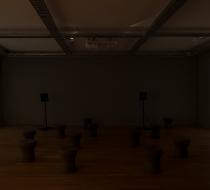Artists in Seven South American Cities Reflect on Past Dictatorships 1 Favorite
*image* Gabriela Golder, “Letters” (photo by Federico Lo Bianco, courtesy Parque de la Memoria)
BUENOS AIRES — Dictatorships and armed conflicts have been all too familiar in South America’s recent histories. To take stock of these experiences, in 2016 the Goethe Institut initiated a regional project in which artists were invited to reflect upon memory and its loss, generating a variety of projects in seven cities across the continent. Artists have tackled essential questions such as: What do we remember, as individuals and a society? And, what have we forgotten? How will we remember in the future? Is memory something fixed or continuously changing, shaped by the present? Thanks to the project, Montevideo, Santiago de Chile, Rio de Janeiro, São Paulo, Bogotá, Lima, and Buenos Aires have become sites to rethink these histories and how they will be remembered in the future.
The project ‘The Future of Memory: Poetics of Memory and Forgetfulness in South America’ originated in Bogotá, just after the peace agreement was signed between the Colombian government and Revolutionary Armed Forces a year and a half ago. The people of Colombia had suffered violence for several decades, leaving generations more divided than united, said Oscar Moreno Escarraga, one of the artists in the project, in an interview with the Deutsche Welle. The only way to counteract this is by talking to and knowing the other, Escarraga suggests with his project Radio Conversa. He assembled a simple house — based upon the dwellings that displaced people build — into a temporary radio station and travelled around the country with it, talking with local people about their memories, revealing Colombia’s social and cultural makeup.
In Lima, Peru, the Goethe facilitated a political theater class at the Universidad del Pacifico where the stage was used for 20 performances that channeled and grappled with recent social injustices. And in Montevideo the collective Hornero Migratorio collaborated with a school’s students and their families to reconstruct children’s games that no longer exist; they then displayed those into a jointly made song, so that these memories could be passed along to another generation.
For nine months, a team of curators, artists, and human rights activists researched the memories of Vila Autodromo, a neighborhood on the outskirts of Rio de Janeiro, which was stripped of its population between 2014 and 2016 because of the Olympics and World Cup. By the end of this project, the former residents came up with the idea of a Museum of the Displaced, placing flags and sharing stories in their former place of dwelling.
Twenty years ago, the public park Parque de la Memoria was created in Buenos Aires as a monument to victims of state terror. To celebrate this milestone, a more conventional exhibition, also titled The Future of Memory, opened last Saturday as part of the Goethe project. It features four very different artistic projects by local artists Marcelo Brodsky, Gabriela Golder, the Etcetera Group, and Mariano Sperrati.
At the exhibition’s opening, the local director of the Goethe Institute, Uwe Mohr, explained the reason behind the German involvement in stimulating these remembrances: “It is very important, also nowadays, to look at the past and learn from it. I grew up in Germany and when you are confronted with the terrible things that have happened in the name of your country, you have to deal and learn to come to terms with it. It remains an important subject, because it is a process. Its urgency comes with waves: currently right-wing movements are on the rise again in Germany and Europe, and we have to continuously look at the past to learn from it for the future and future generations.”
Mohr added that he was particularly enchanted by Gabriela Golder’s decision to incorporate children into her video installation “Letters.” Golder went through the archives of the National Library and selected letters written by imprisoned or exiled mothers to their children during Argentina’s dictatorship. They are read aloud by youngsters of the same age as the addressees. One of the readers was present and met the author of the letter she had read. “That encounter was the highlight of the project,” Golder shared.
Other artists in the exhibition similarly rescued archival material. Mariano Speratti used audio recordings, such as propaganda and publicity aired during the dictatorship, while Marcelo Brodsky researched the archive of CELS, an organization that has been collecting information on people who have disappeared since the 1970s. Brodsky excitedly explained that it’s the first time these documents have left the institute and are visible for a larger audience. “They are part of our cultural heritage. What we see here is all original — look: this is from September 1976!” he said, while pointing at a newspaper clipping noting the disappearance and killing of people in the streets of Buenos Aires.
........ (continued at link)







